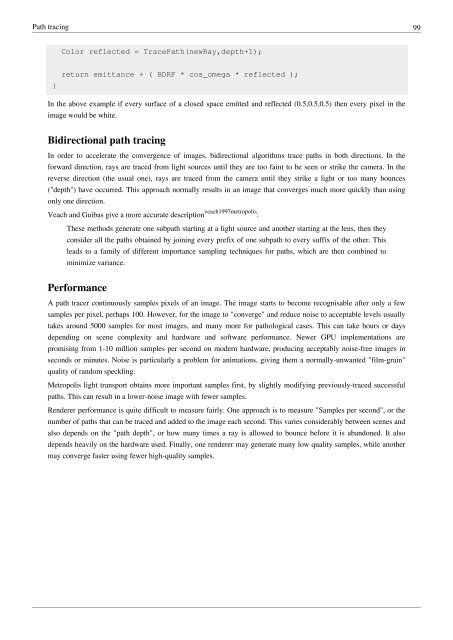3D graphics eBook - Course Materials Repository
3D graphics eBook - Course Materials Repository
3D graphics eBook - Course Materials Repository
You also want an ePaper? Increase the reach of your titles
YUMPU automatically turns print PDFs into web optimized ePapers that Google loves.
Path tracing 99<br />
}<br />
Color reflected = TracePath(newRay,depth+1);<br />
return emittance + ( BDRF * cos_omega * reflected );<br />
In the above example if every surface of a closed space emitted and reflected (0.5,0.5,0.5) then every pixel in the<br />
image would be white.<br />
Bidirectional path tracing<br />
In order to accelerate the convergence of images, bidirectional algorithms trace paths in both directions. In the<br />
forward direction, rays are traced from light sources until they are too faint to be seen or strike the camera. In the<br />
reverse direction (the usual one), rays are traced from the camera until they strike a light or too many bounces<br />
("depth") have occurred. This approach normally results in an image that converges much more quickly than using<br />
only one direction.<br />
Veach and Guibas give a more accurate description veach1997metropolis :<br />
These methods generate one subpath starting at a light source and another starting at the lens, then they<br />
consider all the paths obtained by joining every prefix of one subpath to every suffix of the other. This<br />
leads to a family of different importance sampling techniques for paths, which are then combined to<br />
minimize variance.<br />
Performance<br />
A path tracer continuously samples pixels of an image. The image starts to become recognisable after only a few<br />
samples per pixel, perhaps 100. However, for the image to "converge" and reduce noise to acceptable levels usually<br />
takes around 5000 samples for most images, and many more for pathological cases. This can take hours or days<br />
depending on scene complexity and hardware and software performance. Newer GPU implementations are<br />
promising from 1-10 million samples per second on modern hardware, producing acceptably noise-free images in<br />
seconds or minutes. Noise is particularly a problem for animations, giving them a normally-unwanted "film-grain"<br />
quality of random speckling.<br />
Metropolis light transport obtains more important samples first, by slightly modifying previously-traced successful<br />
paths. This can result in a lower-noise image with fewer samples.<br />
Renderer performance is quite difficult to measure fairly. One approach is to measure "Samples per second", or the<br />
number of paths that can be traced and added to the image each second. This varies considerably between scenes and<br />
also depends on the "path depth", or how many times a ray is allowed to bounce before it is abandoned. It also<br />
depends heavily on the hardware used. Finally, one renderer may generate many low quality samples, while another<br />
may converge faster using fewer high-quality samples.
















